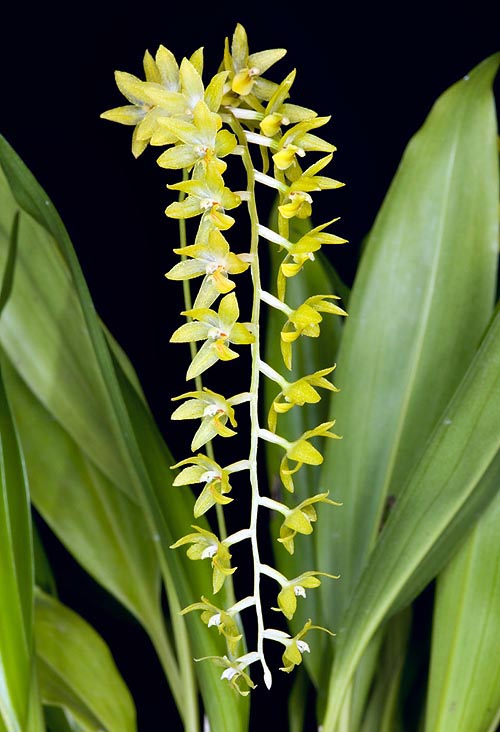Family : Orchidaceae

Text © Pietro Puccio

English translation by Mario Beltramini

Dendrochilum uncatum forms pretty hanging 15-25 cm inflorescences © G. Mazza
The name of the genus is the combination of the Greek terms “déndron” = tree and “cheilos” = lip, with reference to its epiphytic nature and to the prominent labellum; the name of the species is the Latin term “uncatum” = bent, provided with a hook, with reference to the two hook-shaped appendices under the anther.
Common names: zu zhu lan (Chinese).
The Dendrochilum uncatum Rchb.f. (1855) is an epiphytic or lithophytic species with ovoid, close, pseudobulbs, 2-4 cm long and with 1-1,5 cm of diameter, provided with one only coriaceous leaf from linear to oblong, 8-20 cm long and 1,5-3,5 cm broad, with pointed apex, of dark green colour.
The inflorescences, which develop at the same time as the new pseudobulb and the new leaf, are curved, 15-25 cm long, carrying 20-30 tiny flowers, alternate and close, regularly placed on two lines, of greenish yellow colour.
The sepals are elliptic with pointed apex, about 6 mm long and 3 mm broad, the petals are oblong or elliptic with pointed apex, of about 5 mm of length and 3 mm of breadth; the labellum, trilobate, is about 5 mm long and 3 mm broad. It reproduces by seed, in vitro, and by division.
Temperate-warm climate species, it requires a much luminous exposition, but not direct sun, or slightly shaded, high atmospheric humidity, 60-80%, with abundant waterings and regular fertilizations in spring-summer, but allowing the compost to partially dry up; in winter the waterings are to be reduced, allowing the compost to dry up almost completely before administering water again, and the minimum night temperatures are to be kept between the 12 and 15 °C.
A good air circulation is essential in all seasons. For the waterings and nebulisations are to be utilized rain water, or water obtained by reverse osmosis, or demineralised and the fertilizations, duly distributed in way to avoid salts accumulation, are to be done preferably with hydro-soluble balanced products, with microelements, at ¼ of the dosage suggested on the package.
It can be cultivated in pot or in basket with draining and aerated compost which may be formed by finely cut bark fragments, charcoal and sphagnum. Repottings and divisions, if necessary, are to be done after the flowering.
The species is inscribed into the appendix II of the CITES (species whose trade is internationally ruled).
Synonyms: Platyclinis uncata (Rchb.f.) N.E.Br. ex B.S.Williams (1894); Acoridium uncatum (Rchb.f.) Rolfe (1904).
→ For general notions about ORCHIDACEAE please click here.
